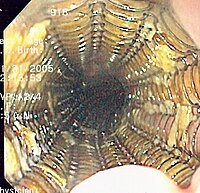
Photo from wikipedia
A 65-year-old woman presented with fever, cough, and right upper quadrant abdominal pain. She had undergone endoscopic retrograde cholangiopancreatography (ERCP) 3 weeks earlier for choledocholithiasis, with stent placement. There was… Click to show full abstract
A 65-year-old woman presented with fever, cough, and right upper quadrant abdominal pain. She had undergone endoscopic retrograde cholangiopancreatography (ERCP) 3 weeks earlier for choledocholithiasis, with stent placement. There was a history of attempted stent removal, which failed, at another institute. At presentation, her laboratory parameters were normal, except for white blood cells of 22570/μL and hemoglobin of 9 g/dL. A computed tomography scan revealed migration of the biliary stent in the pleura (▶Fig. 1). During ERCP, a migrated biliary stent was noted in the right pleural cavity at fluoroscopy (▶Video 1), which was removed using a rat tooth alligator jaw grasping forceps (FG-42L-1; Olympus, Tokyo, Japan) (▶Fig. 2). The common bile duct (CBD) was cannulated, and cholangiogram revealed a dilated CBD with stones and extravasation of contrast into the pleura (▶Fig. 3). Endoscopic sphincteroplasty was performed using a controlled radial expansion wire-guided balloon up to 12mm (Boston Scientific, Marlborough, Massachusetts, USA). Multiple balloon sweeps were done (▶Fig. 4) and stones were retrieved (▶Fig. 5). Complete ductal clearance was achieved. A prophylactic 10 Fr plastic biliary stent was inserted. The patient was advised to undergo cholecystectomy and subsequent stent removal. Stent migration into the pleura is a late complication and rarely encountered, and to the best of our knowledge has not been reported previously. Biliary stents have been routinely used during ERCP for benign and malignant conditions [1]. However, the incidence of migration varies between 8% and 10% [2, 3], with complications including cholangitis and perforation. The common sites for migration include the CBD, duodenum, and colon [3]. Despite being commonly encountered, these patients are usually asymptomatic. Biliary stents can perfoVideo 1 Migrated biliary stent seen in right pleural cavity.
Journal Title: Endoscopy
Year Published: 2023
Link to full text (if available)
Share on Social Media: Sign Up to like & get
recommendations!